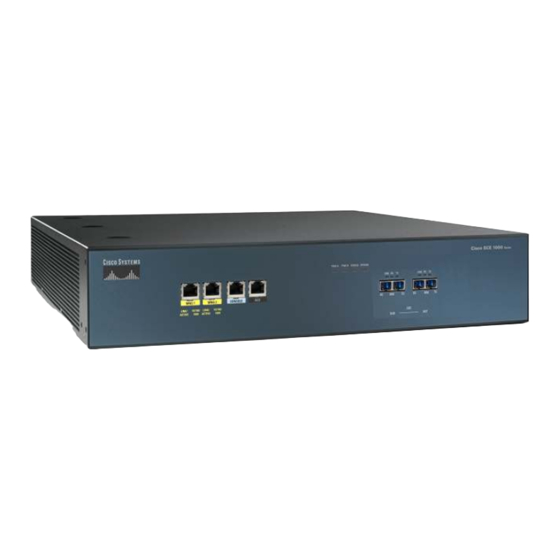Cisco SCE 1000 and Hızlı Başlangıç Kılavuzu - Sayfa 26
Ağ Donanımı Cisco SCE 1000 and için çevrimiçi göz atın veya pdf Hızlı Başlangıç Kılavuzu indirin. Cisco SCE 1000 and 49 sayfaları. Service control engine 1000 2xgbe

Example 2:
This example skips the first section of the dialog (creating/modifying), and proceeds directly to assign existing ACLs.
Would you like to enter the Access lists configuration menu? [no]: y
Would you like to create new Access lists or modify existing lists? [no]:
Enter IP access-class [0]: 10
Enter Telnet access-class [0]: 22
Step 8: Configuring SNMP
Managing the SCE 1000 is possible also via a Network Management System (NMS) that supports SNMP. By default, SNMP is
disabled on the SCE 1000.
To enable SNMP management you must configure the following basic SNMP parameters:
• SNMP traps status and managers.
• Community strings (where an SNMP community string is a text string that acts like a password to permit access to the
SNMP agent on the SCE 1000).
Summary Steps
1. Enter the SNMP configuration menu.
2. Enable SNMP management.
3. Configure the SNMP GET community.
4. Type the SNMP GET community name and press Enter.
5. Assign an access list to restrict the SNMP management stations that may use this GET community.
6. Configure additional GET communities.
7. To add more entries, do not accept the default.
8. Enter up to 20 SNMP GET communities as described in step 3.
9. When all entries have been added, accept the default:
10. Configure the SNMP SET community.
11. Type the SNMP SET community name and press Enter.
12. Assign an access list to restrict the SNMP management stations that may use this SET community.
13. Configure additional SET communities.
14. To add more entries, do not accept the default:
15. Enter up to 20 SNMP SET communities as described in step 5.
16. When all entries have been added, accept the default:
17. Configure the SNMP trap managers.
18. Enter the SNMP trap managers menu.
19. Configure the trap manager IP address
20. Configure the trap manager community string
21. Configure the trap manager SNMP version.
22. Configure additional trap managers.
23. To add more entries do not accept the default:
24. Enter up to 20 trap managers as described in step 7.
25. When all entries have been added, accept the default:
26. Configure the Authentication Failure trap status.
27. Configure the SCE enterprise trap status.
28. Specify the system administrator.
26
